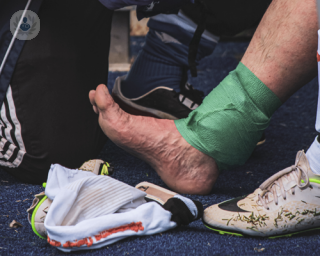Sprained ankle
Mr Matthew Solan - Orthopaedic surgery
Created on: 11-13-2012
Updated on: 09-07-2023
Edited by: Conor Lynch
What is a sprained ankle?
A sprained ankle is an injury of the ankle ligaments caused by twisting or being stretched beyond their limit of movement. There are three types of sprained ankle, classified by severity:
- Grade I sprains are the least severe. Ankle ligaments are not torn. Swelling and pain are mild. There may be effusion (the collection of fluid in the joint). In this case, it is possible to resume physical activity after a short period with a functional bandage.
- In grade II sprains, ligaments are partially torn. Pain and swelling are greater. Fewer foot movements can be made.
- In grade III sprains, ligaments are completely torn. Pain is intense. Foot movement is very restricted. The injury is accompanied by much greater effusion, and hence surgery is sometimes required.
The right specialist for treating an ankle sprain is a specialist in orthopaedics.

What is the prognosis of a sprained ankle?
Generally, the majority of sprained ankles are mild injuries. However, some cases can be more serious, requiring longer recoveries, and sometimes surgery.
What are the main symptoms associated with a sprained ankle?
The most relevant signs and symptoms of ankle sprains include the following:
- moderate pain
- weakness
- inflammation
- haematoma
- joint rigidity
- difficulty walking
How is an ankle sprain diagnosed?
The diagnosis of an ankle sprain is essentially clinical, and is based on the review of the patient’s history and a physical examination, via evaluating manoeuvres, such as the anterior drawer test, the forced inversion test, the forced external rotation test, and the squeeze test. An X-ray may be very helpful in ruling out associated bone fractures or complete ligament tears.
What can cause an ankle sprain?
A sprain may be caused by a direct impact on the ankle, following a fall, or by tripping over. In women, one of the primary causes of ankle sprains is wearing high-heeled shoes.
How can one try to avoid an ankle sprain?
It is impossible to prevent a sprained ankle, but we can adopt several measures to reduce the probability of ankle sprains. They include:
- always perform warm-up exercises before any strenuous physical activity
- take extra care when walking or running over uneven surfaces
- avoid carrying out physical activities when tired
- use compression bandages, ankle supports, or high-top footwear
- wear high-quality footwear, of the right size and laced-up correctly

How is a typical ankle sprain treated?
Generally, surgery is not necessary in the treatment of ankle injuries, given that the majority of ankle sprains are mild injuries that heal with minimal treatment.
Generally, treatment for ankle sprains consists of:
- resting the ankle (at least the first two days)
- cooling down the affected area for 20 minutes every two or three hours with ice
- compressing with an ankle brace and elevating the leg so that the toes are above the level of the nose
- physiotherapy may also be important for recovery
What are the most effective medications for sprained ankles?
Anti-inflammatory medications provide pain relief and reduce swelling.
What can recurrent ankle sprains lead to?
Recurrent spraining of one's ankle can lead to chronic ankle instability as well as arthritis.
Do sprained ankles require surgery?
Thankfully, most people who have sprained their ankle have recovered fully without the need for any surgical intervention. A handful of patients may benefit from ankle surgeries such as either arthroscopic surgery or ankle reconstruction surgery.
When can I return to sport if I have sprained my ankle?
When it comes to mild ankle sprains, the vast majority of them fully heal within either a few days or a few weeks maximum. Severe ankle sprains, meanwhile, more often than not take a couple of months to fully heal.
What is the difference between a broken or fractured ankle and a sprained ankle?
Ankle sprains occur when ankle ligaments are damaged, whilst ankle fractures or breaks result from one or more of the ankle bones break.












